Having dropped points against Club Brugge at the Estadio Santiago Bernabéu in their only home Champions League fixture to date, a victory was required for Zinedine Zidane’s Real Madrid against Galatasaray. They did just that and in emphatic style.
It took only five minutes for youngster Rodrygo Goes to open the scoring, adding a second literally a couple of minutes later with a smart header. Sergio Ramos then took a penalty, won by Toni Kroos after Steven N’Zonzi tripped him on the edge of the box, with Karim Benzema adding a fourth on the stroke of half-time. In the second half, Benzema struck again with a neat tap-in, whilst Rodrygo would secure his hat-trick with the last kick of the game in similar fashion.
This tactical analysis will consider the tactics of both sides, Real Madrid and Galatasaray, as Zidane’s men overcame Fatih Terim’s team in a 6-0 win. The analysis of this UEFA Champions League fixture will use statistics to see how the game was won.
Line-ups
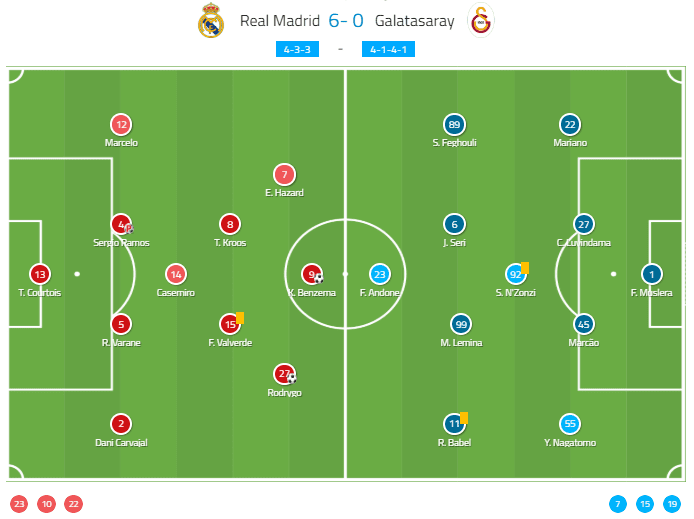
Real Madrid stuck with their preferred side of late, with Fede Valverde keeping his place in midfield and Rodrygo maintaining his spot in attack for a fourth consecutive start. Marcelo started at left-back, returning having been rested at the weekend, but was forced off before half-time as a precaution.
Galatasaray sprung no surprises with their line-up either, sticking to their preferred 4-1-4-1 shape and recalling the likes of Sofiane Feghouli, and N’Zonzi after they were rested at the weekend. A double swap at half-time changed that, with Terim opting for greater solidity in defence and more pace in attack with Omer Bayram coming on to freshen things up on the counter.
Rodrygol
Beyond scoring the fastest ever brace in a Champions League game and the second-youngest player to ever score a hat-trick in the competition after Raúl, Rodrygo netted a perfect hat-trick in his first Champions League outing at the Bernabéu. Lining up on the right, his positioning was particularly interesting as he later transitioned into more of a central role, abandoning the width which had served him so well earlier on, reflecting his ability to read the game and understand how Galatasaray looked to stock up on the wings in an attempt to shut him down.
Deployed on the right to start with, he quickly found ways to exploit the space available and his smart movement and reading of the game capitalised on that. In total, he only attempted three shots, scoring them all, reflecting the way in which Rodrygo was keen to bide his team as he picked and chose his opportunities well, refusing to get carried away by the occasion. Even then, his effective dribbling, completing three, and technical abilities allowed him to make an impact, influencing all of Real Madrid’s offensive play when he wasn’t directly on the ball taking a shot.
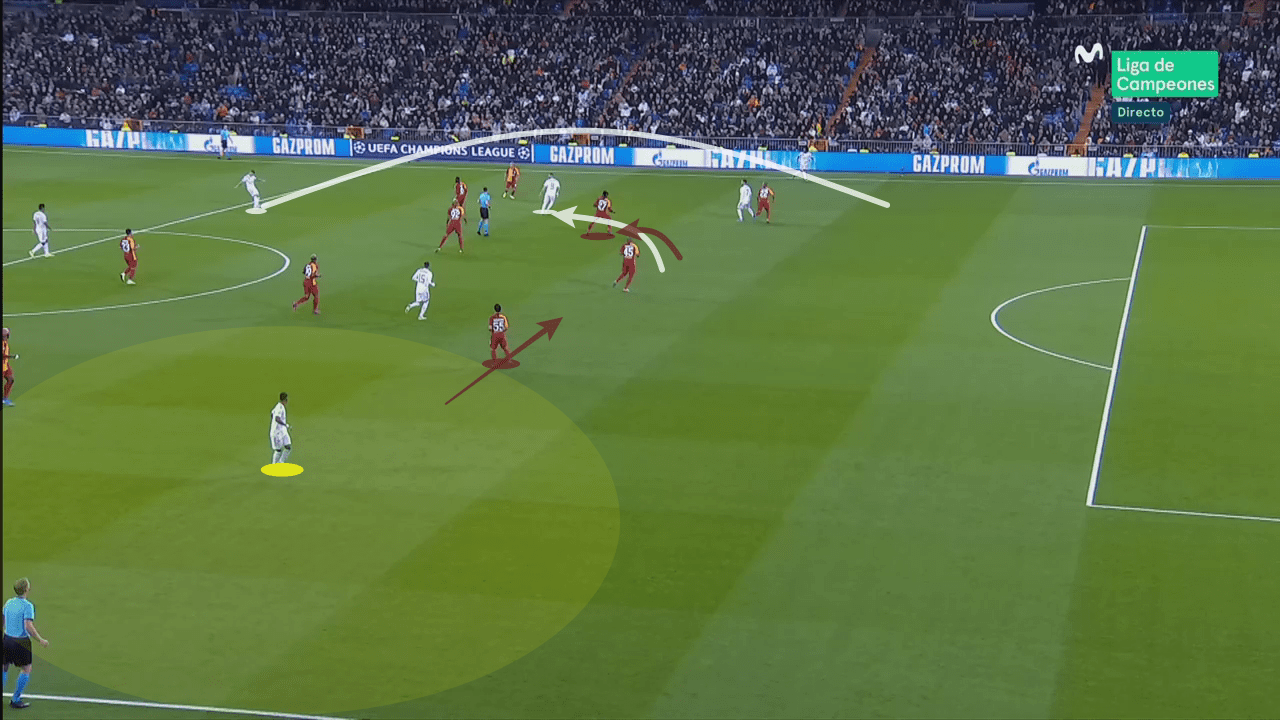
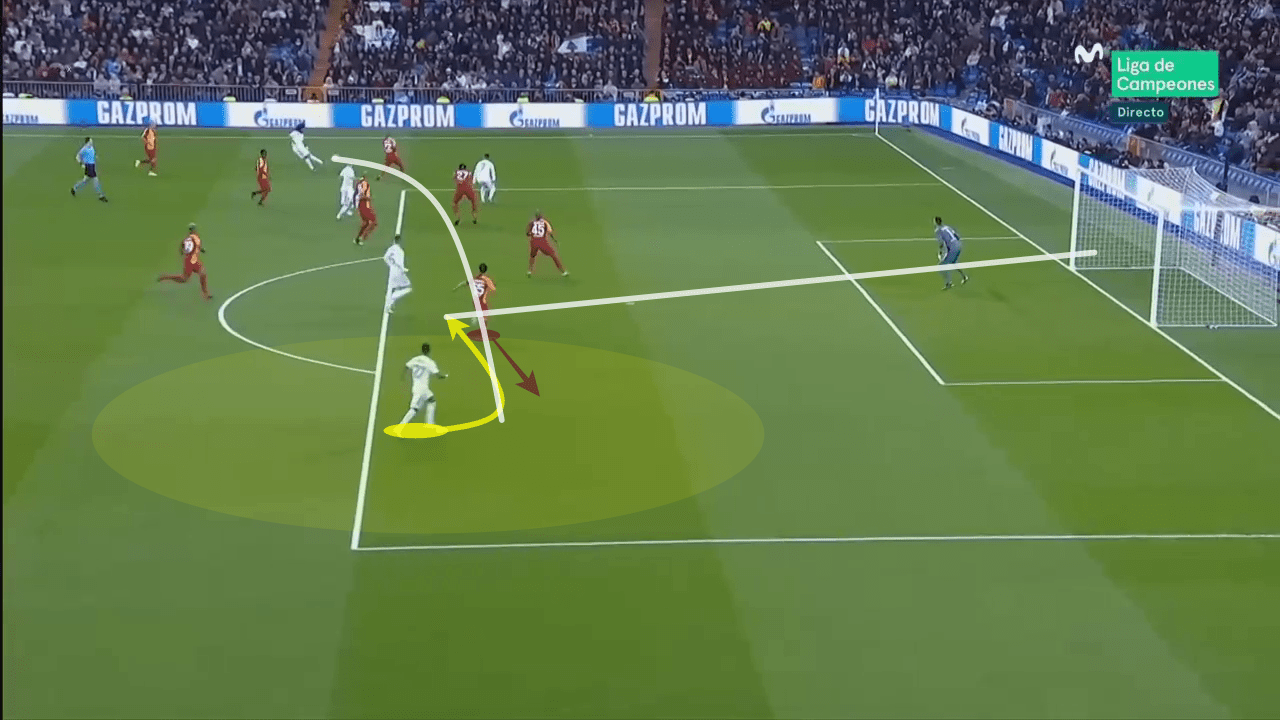
The best example of this movement was in his first goal, as shown above. As the ball entered the Galatasaray half, before the ball was played down the left flank, Rodrygo had already identified the opportunity. Benzema moved up to provide a short passing option, forcing Christian Luyindama up along with him and the rest of the defence across, opening up space on the right for Rodrygo to attack. By the time the cross came in, Rodrygo could anticipate that the defenders would be wrong-footed as he cut back inside, giving him time to get his shot away.
Fede’s flexibility
Only once in his career has he been more involved, with 105 total actions only surpassed by the 106 he recorded against UD Melilla in the Copa del Rey last season. The Uruguayan was all over the park and covered every blade of glass in a hugely flexible role which saw him go from leading the offensive side of Real Madrid’s midfield to sitting in as a third central defender. Such energy and intensity is crucial for success as it is exactly what Zidane has been missing this season, but Valverde is now continuing to prove that he can offer just that.
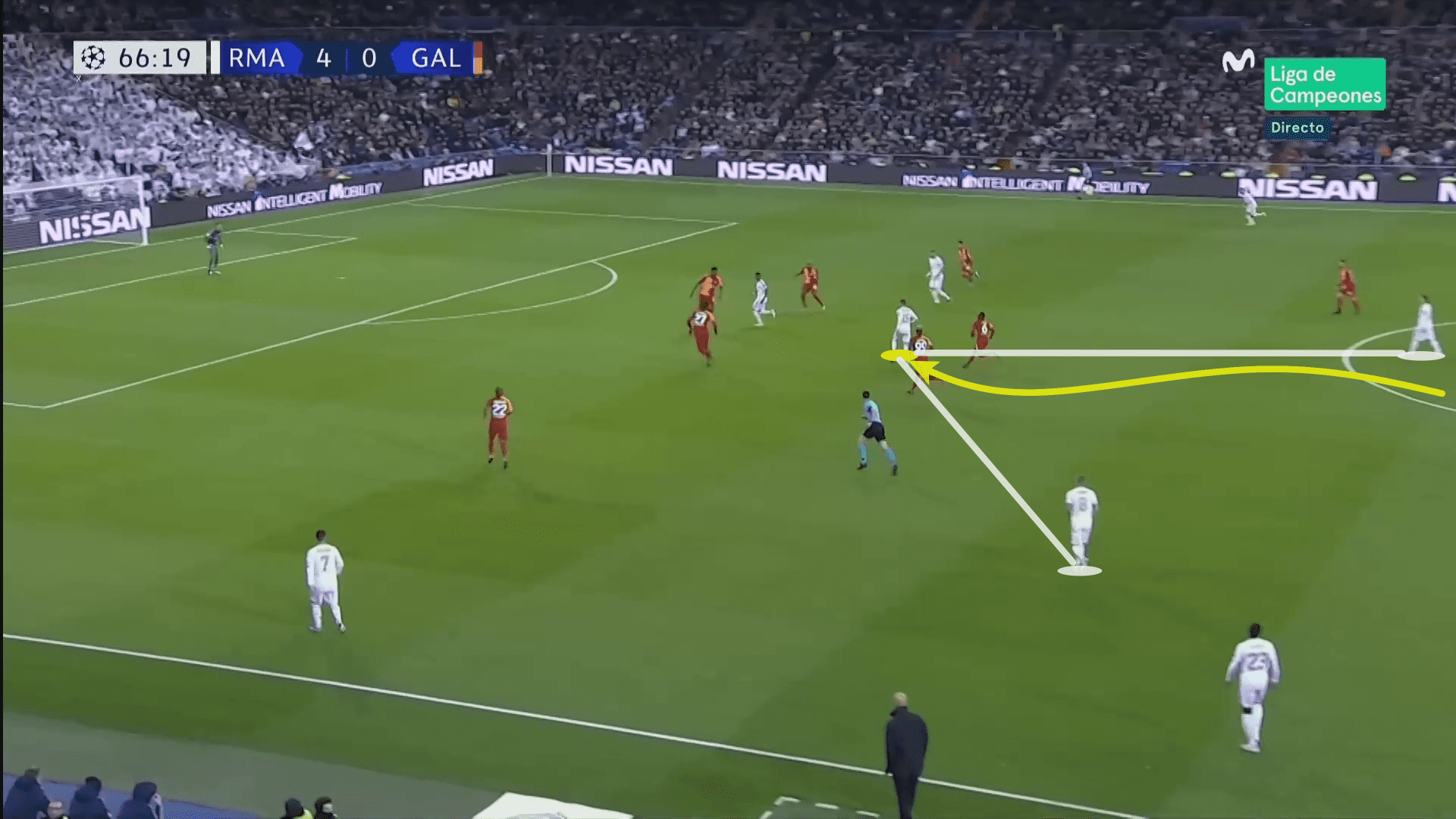
Valverde carried the ball forwards to drive the team into the offensive third, as was the case in the above example. He made three such progressive runs and was essential in pushing the side forward, particularly in the second half when the intensity began to drop. With a 95% pass accuracy, 100% of his passes into the final third and 16 of his 17 forward passes were completed. Such accuracy on the ball kept the Real Madrid midfield ticking over throughout the tie and was an essential part of Los Blancos’ build-up play.
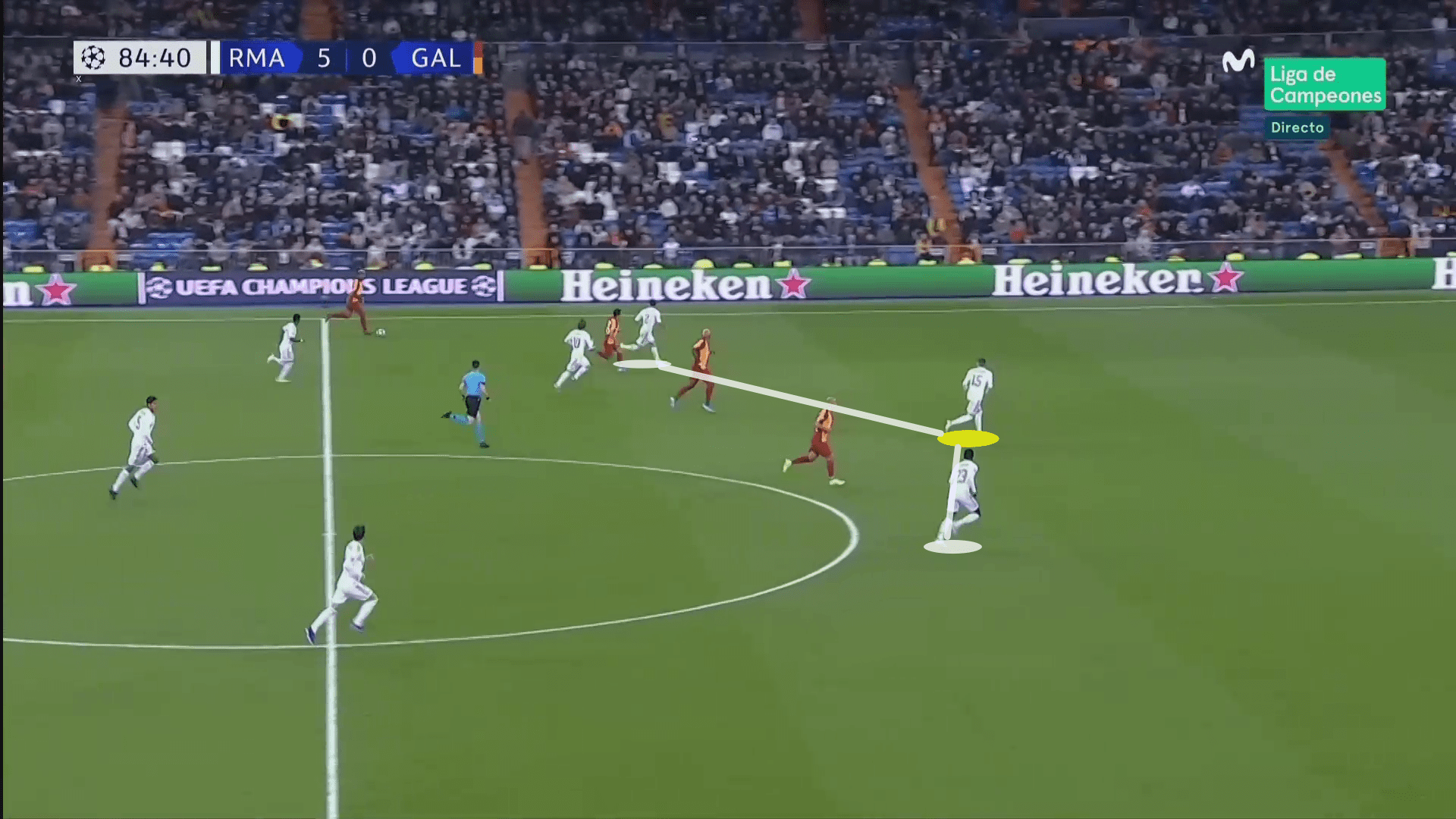
Once Luka Modrić was introduced in the second half, Valverde dropped into a deeper role, taking up Casemiro’s holding midfield role. Here, he dropped even deeper than the Brazilian typically would. As can be seen here, he operated as a third central defender, allowing both full-backs complete freedom to push forward and support the front line down the flanks. He won six of his seven defensive duels in this role, in addition to six interceptions. Even before that, he was actively defending from the front, with five of his eight recoveries coming in the opposition half. It has been some time since a single player stood out so significantly in a Real Madrid shirt, and few expected it to be Valverde to produce such a display.
Galatasaray penned in
Not since records began in 2015 have Galatasaray recorded fewer than the 30 passes in the final third that the Turkish side recorded. In the first half particularly, there were spells of the game where they failed to even get out of their own half and even at 3-0 down were being forced back into their own box showing little ambition. Only Florin Andone had an average position in Real Madrid’s half, with every other player spending more time camped in their own half looking to form part of a solid defensive unit. Despite that, Real Madrid still managed to regularly find a way through.
This was down to the smart movement of Real Madrid’s attackers, with Benzema, in particular, disrupting the rigid defensive lines of Galatasaray. As defenders and N’Zonzi in holding midfield were pulled out of position, it opened up spaces for others to exploit and made it even more difficult for the visitors to turn over possession and look to attack. With so many players positioned so deeply, it meant that there was no outlet for the ball to be passed to even when that was the case.
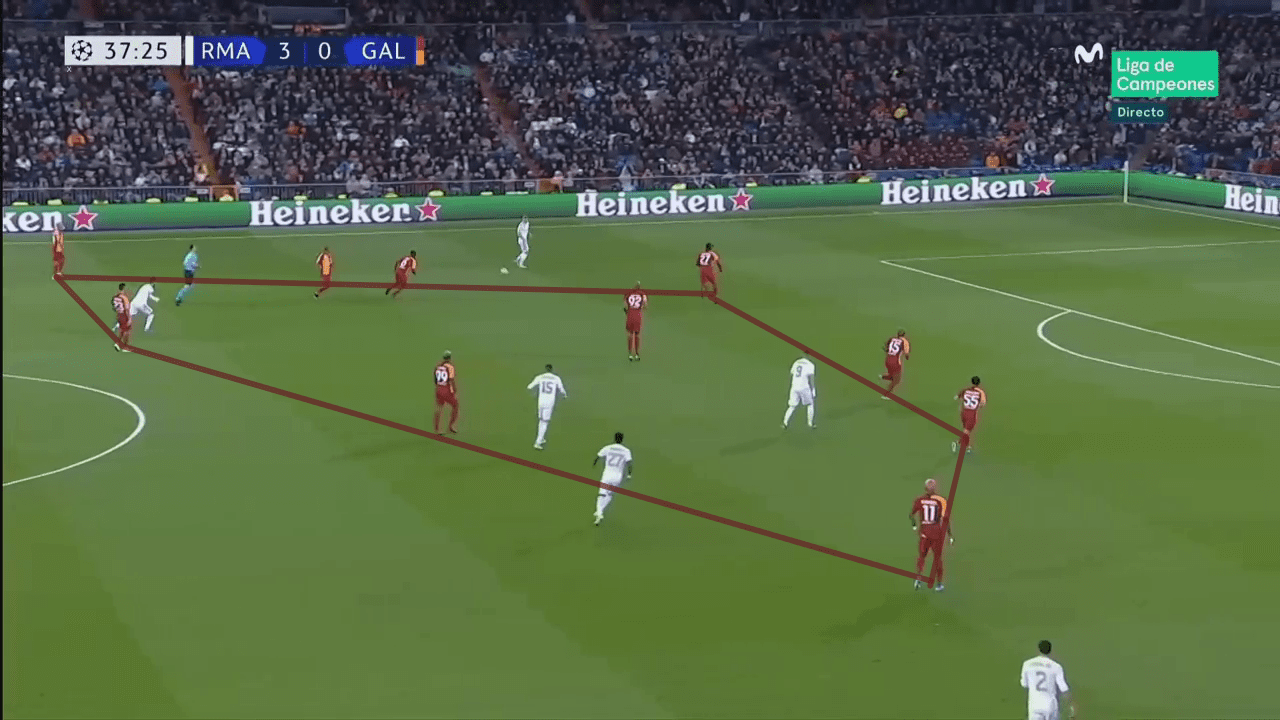
In the second half, after Terim made his double substitution, Galatasaray did begin to show more signs of intent. Whilst they still struggled to get into the final third or pose any threat, making just 16 passes into the danger area, with 11 of those coming in the final 15 minutes, they did look more threatening on the counter-attack. Bayram’s introduction, alongside Feghouli on the opposite flank, provided pace which looked to pin back the Real Madrid full-backs and then exploit the space they left behind when on the counter. It worked somewhat, though not significantly enough to disrupt the central pairing of Ramos and Varane.
Conclusion
Rodrygo grabbed all the headlines, and deservedly so, but the beating heart of this performance, the best of Real Madrid’s season in terms of their clinical and creative attacking play, was Valverde in the middle of the park. Such energy provided Real Madrid with the kind of dynamic movement that they needed, with Valverde disrupting the midfield and Rodrygo and Benzema combining to tear the Galatasaray defence apart. Galatasaray’s system did them few favours, but it was Real Madrid’s movement and intelligence off the ball which told to make the difference in this clash.

If you love tactical analysis, then you’ll love the digital magazines from totalfootballanalysis.com – a guaranteed 100+ pages of pure tactical analysis covering topics from the Premier League, Serie A, La Liga, Bundesliga and many, many more. Buy your copy of the November issue for just ₤4.99 here





Comments